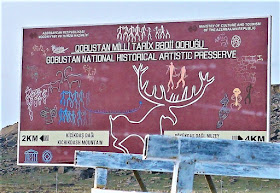We visited two national parks back-to-back in Azerbaijan: Shirvan and Gobustan.
1. Shirvan National Park is a small (about 200 square miles) park 60 miles southwest of Baku that was formed primarily to protect the goitered gazelle, seen atop the tower below:
There are other animals there, of course, but none so important--or visible--as the gazelle that gets is name from the way its neck puffs out during mating season. The park has had a very successful breeding program--they started with 131 gazelles in 1961 and now have over 8,000. We saw quite a few:
Here is a fairly good shot of the "goiter" in the male's neck:
Our other wildlife sightings included a very cute (and not very wild) kitty:
This picturesque dove cote could be almost anywhere in the world:
Look carefully. Do you see something hiding in the bushes out there?
It was some kind of a fox:
This land used to be at the bottom of the Caspian Sea, and it is still below sea level. Ten to fifteen percent of the park is water reservoirs:
We weren't as focused on the birds, but we did see some kind of an egret:
. . . and a black kite:
The grasses themselves were quite beautiful:
I love this little bridge that appears to made from bamboo. There are tire tracks leading to it. Did we drive over it? I can't remember, but it doesn't look sturdy enough to hold a car:
2. Gobustan (also spelled Qobustan) National Park is famous for its rock carvings, mud volcanoes, and stone pots.
We started at a funky museum near the parking lot:
It was full of unusual dioramas:
The museum also documents some of the early man archaeological finds:
The official name of this UNESCO World Heritage site is the Gobustan Rock Art Cultural Landscape Resesrve:
The variable, dramatic rock formations alone are worth a trip:
Can you pick out some engravings in the rocks below?
Here is a close-up of the dancing figures. Incredible, isn't it?
That cow figure in the center is an aurochs, a now extinct species of cattle that used to cover this area:
We saw lots of aurochses (aurochsen? aurochsi?):
The curly horns look like a kudu to me:
A somewhat primitive glyph of a man on a horse:
A more skilled rendition of a horse:
Somehow the human figures look as though they are moving:
After all, SHE gets to touch:
More
Signs like this get Bob excited. Unfortunately (or fortunately, depending whom you ask), no venomous vipers appeared:
These deep holes were carved into the rock as a kind of a well to catch rain water. They date back to the Bronze Age (3300-1200 BC). The numbers are a recent, and in my view unfortunate, addition:
We only saw a very small part of the park. Other sections have mud pots (aka mud volcanoes), which I would love to have seen. Apparently Azerbaijan has 300 of the earth's 700 mud pots, and most of them are in Gobustan.
Gobustan is an aspiring rock artist's dream:








































































We had visiting mud volcanoes on the itinerary, but recent rains made the dirt roads impassable. I loved the gazelles in Shirvan and enjoyed comparing Azerbaijani efforts to protect wildlife to U.S. efforts I've seen. The age of the rock art and the quality are quite amazing.
ReplyDelete